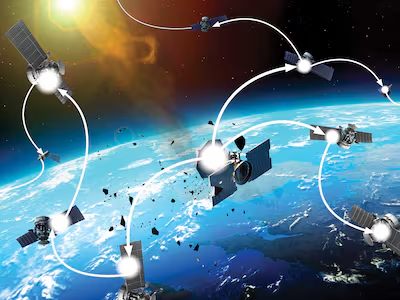The largest solar flare of the current cycle, and the most intense seen since 2017 struck Earth today at 5.51pm BST.
The 8.7X-class sunspot complex was emitted from active region 3,664, producing the 17th most intense flare recorded.
The solar flare could lead to a complete loss of radio signals on the sunlit side of Earth.
A flare is an eruption of energy from the Sun, which generally lasts minutes to hours, and they are not often of the magnitude witnessed on Tuesday afternoon.
Since Friday, the most powerful solar storm to strike our planet in more than two decades has lit up night skies with dazzling auroras in the US, southern Australia, the Bahamas and other places far from the extreme latitudes where they are normally seen.
The first of several coronal mass ejections – expulsions of plasma and magnetic fields from the Sun – came just after 5pm BST Friday, according to the US-based National Oceanic and Atmospheric Administration.
Northern lights appear in the night skies - in pictures
The event was later upgraded to an "extreme" geomagnetic storm, the first since the "Halloween Storms" of October 2003 that caused blackouts in Sweden and damaged power infrastructure in South Africa.
Excitement over the phenomenon, and otherworldly photos of pink, green and purple night skies, broke out around the world, from southern Europe to Australia's island state of Tasmania.
The storm had been forecast to intensify again until 5am BST on Monday, the administration said, adding that auroras could be seen as far south as New York.
The solar cycle as seen from space
But thousands of people who went out on Sunday night in the hope of seeing the aurora borealis over the Joshua Tree National Park in California saw only the glittering stars of the Milky Way.
"Only the most experienced photographers will be able to capture them" in lower latitudes such as France, said Eric Lagadec, an astrophysicist at France's Observatoire de la Cote d'Azur.
The geomagnetic storm was caused when CMEs from a massive sunspot cluster 17 times wider than Earth arrived at our planet at around the same time.
But the sunspot has now moved to "the edge of the Sun … we do not expect the next coronal mass ejections to head in Earth's direction", Mr Lagadec said.
Does an active Sun affect the Earth's climate?

"However, the behaviour of the Sun is really hard to predict," said Quentin Verspieren, the European Space Agency's space safety programme co-ordinator.
And we are only just entering a period of increased solar activity that occurs every 11 years when the Sun's magnetic pole flips, which means there could be further extreme events in the next year or two, Mr Verspieren said.
When charged particles from solar winds are captured by Earth's magnetic field, they accelerate towards the planet's magnetic poles, which is why auroras are normally seen there.
But during periods of increased solar activity, the effects extend farther toward the equator.

Unlike during 2003's solar storms, no major disruptions to power or communications networks appear to have been reported this time around.
Elon Musk's satellite internet operator Starlink said on X that its thousands of satellites in low Earth orbit had "weathered the geomagnetic storm and remain healthy".
Unlike solar flares, which travel at the speed of light and reach Earth in about eight minutes, CMEs travel at a more sedate pace, with officials putting the current average at 800km a second.
Fluctuating magnetic fields associated with geomagnetic storms induce currents in long wires, including power lines, which can lead to power cuts. Long pipelines can also become electrified.
Spacecraft are at risk from high doses of radiation, although the atmosphere prevents this from reaching Earth.
Nasa can ask astronauts on the International Space Station to move to better-shielded places within the outpost.
















